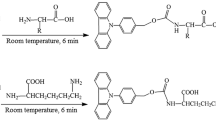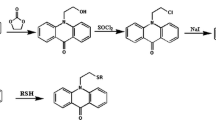Abstract
A novel high-performance liquid chromatography–fluorescence analysis in combination with in situ degradation–derivatization (ISD-D) technique was developed for simultaneous determination of seven organophosphorus thioester pesticides (OPTPs) in tea. The ISD-D technique was based on degradation of OPTPs by a nucleophilic substitution reaction between phenylbutane-1,2,3-trione-2-oxime and OPTPs, which can give thiol degradation products (DPs). The thiol DPs obtained were derivatized with the novel derivatization reagent N-(4-(carbazole-9-yl)-phenyl)-N-maleimide (NCPM) in a syringe. Attractively, NCPM itself did not fluoresce, whereas the derivatives of the thiol DPs fluoresced intensely, with excitation and emission maxima at 290 nm and 368 nm, respectively, which extraordinary reduced the background interference and increased the detection sensitivity for thiol DPs. Excellent linearity (R2 > 0.995) for all OPTPs was achieved, with limits of detection and limits of quantitation ranging from 0.23 to 0.45 μg/kg and from 0.75 to 1.43 μg/kg, respectively. Satisfactory recoveries ranging from 90.5% to 96.0% were obtained for all OPTPs. The ISD-D technique provided a novel and sensitive strategy for quantitation of trace amounts of OPTPs in real samples.

ᅟ








Similar content being viewed by others
References
Chen H, Gao G, Chai Y, Ma G, Hao Z, Wang C, et al. Multiresidue method for the rapid determination of pesticide residues in tea using ultra performance liquid chromatography Orbitrap high resolution mass spectrometry and in-syringe dispersive solid phase extraction. ACS Omega. 2017;2(9):5917–27.
Lu C, Liu X, Dong F, Xu J, Song W, Zhang C, et al. Simultaneous determination of pyrethrins residues in teas by ultra-performance liquid chromatography/tandem mass spectrometry. Anal Chim Acta. 2010;678(1):56–62.
Xu X-M, Yu C, Han J-L, Li J-P, El-Sepai F, Zhu A, Huang B-F, Cai Z-X, Wu H-W, Ren Y-P. Multi-residue analysis of pesticides in tea by online SEC-GC/MS. J Sep Sci. 2011;34(2):210-6.
Raal A, Orav A, Püssa T, Valner C, Malmiste B, Arak E. Content of essential oil, terpenoids and polyphenols in commercial chamomile (Chamomilla recutita L. Rauschert) teas from different countries. Food Chem. 2012;131(2):632–8.
Steele VE, Kelloff GJ, Balentine D, Boone CW, Mehta R, Bagheri D, Sigman CC, Zhu S, Sharma S. Comparative chemopreventive mechanisms of green tea, black tea and selected polyphenol extracts measured by in vitro bioassays. Carcinogenesis. 2000;21(1):63-7.
Hamer M. The beneficial effects of tea on immune function and inflammation: a review of evidence from in vitro, animal, and human research. Nutr Res. 2007;27(7):373-9.
Sharangi AB. Medicinal and therapeutic potentialities of tea (Camellia sinensis L.) – a review. Food Res Int. 2009;42(5):529–35.
Shamsipur M, Yazdanfar N, Ghambarian M. Combination of solid-phase extraction with dispersive liquid–liquid microextraction followed by GC–MS for determination of pesticide residues from water, milk, honey and fruit juice. Food Chem. 2016;204:289–97.
Kamel F, Hoppin JA. Association of pesticide exposure with neurologic dysfunction and disease. Environ Health Perspect. 2004;112(9):950–8.
Pope CN. Organophosphorus pesticides: do they all have the same mechanism of toxicity? J. Toxicol Environ Health Part B. 1999;2(2):161–81.
L. K. Organophosphorus poisoning and anaesthesia. Anaesthesia. 1999;54(11):1073–88.
Eskenazi B, Bradman A, Castorina R. Exposures of children to organophosphate pesticides and their potential adverse health effects. Environ Health Perspect. 1999;107(Suppl 3):409–19.
Campillo N, Peñalver R, Hernández-Córdoba M. Pesticide analysis in herbal infusions by solid-phase microextraction and gas chromatography with atomic emission detection. Talanta. 2007;71(3):1417–23.
Abd El-Aty AM, Choi J-H, Rahman MM, Kim S-W, Tosun A, Shim J-H. Residues and contaminants in tea and tea infusions: a review. Food Addit Contam Part A Chem Anal Control Expo Risk Assess. 2014;31(11):1794–804.
Cortés JM, Sanchez R, Díaz-Plaza EM, Villén J, Vázquez A. Large volume GC injection for the analysis of organophosphorus pesticides in vegetables using the through oven transfer adsorption desorption (TOTAD) interface. J Agric Food Chem. 2006;54(6):1997–2002.
Liu W, Hu Y, Zhao J, Xu Y, Guan Y. Determination of organophosphorus pesticides in cucumber and potato by stir bar sorptive extraction. J Chromatogr A. 2005;1095(1):1–7.
Kim N, Park I-S, Kim D-K. High-sensitivity detection for model organophosphorus and carbamate pesticide with quartz crystal microbalance-precipitation sensor. Biosens. Bioelectron. 2007;22(8):1593-9.
Kuśmierek K, Chwatko G, Głowacki R, Kubalczyk P. Bald E Ultraviolet derivatization of low-molecular-mass thiols for high performance liquid chromatography and capillary electrophoresis analysis. J Chromatogr B, 307. 2011;879:1290.
Cao L-W, Tan X-F, Li C, Wu C, Zhang Z-D, Deng T, et al. Capillary electrophoresis-laser induced fluorescence detection of GABA and its analogs in human serum with solid-phase extraction and fluorescein-based probes. Anal Methods. 2013;5(21):6000–8.
Kumar V, Raviraju G, Rana H, Rao VK, Gupta AK. Highly selective and sensitive chromogenic detection of nerve agents (sarin, tabun and VX): a multianalyte detection approach. Chem Commun. 2017;53(96):12954–7.
Chassaing C, Gonin J, Wilcox CS, Wainer IW. Determination of reduced and oxidized homocysteine and related thiols in plasma by thiol-specific pre-column derivatization and capillary electrophoresis with laser-induced fluorescence detection. J Chromatogr B. 1999;735(2):219–27.
Chen X, Zhou Y, Peng X, Yoon J. Fluorescent and colorimetric probes for detection of thiols. Chem Soc Rev. 2010;39(6):2120–35.
Lv Z, Sun Z, Song C, Lu S, Chen G, You J. Sensitive and background-free determination of thiols from wastewater samples by MOF-5 extraction coupled with high-performance liquid chromatography with fluorescence detection using a novel fluorescence probe of carbazole-9-ethyl-2-maleimide. Talanta. 2016;161:228–37.
Suzukida M, Le HP SF, AR MP, Birnbaum ER, Darnall DW. Resonance energy transfer between cysteine-34 and tryptophan-214 in human serum albumin. distance measurements as a function of pH. Biochemistry. 1983;22:2415–20.
Bidari A, Ganjali MR, Norouzi P, Hosseini MR, Assadi Y. Sample preparation method for the analysis of some organophosphorus pesticides residues in tomato by ultrasound-assisted solvent extraction followed by dispersive liquid-liquid microextraction. Food Chem. 126(4):1840–4.
Moinfar S, Hosseini MR. Development of dispersive liquid-liquid microextraction method for the analysis of organophosphorus pesticides in tea. J Hazard Mater. 169(1-3):907–11.
Cheng Z, Dong F, Xu J, Liu X, Wu X, Chen Z, et al. Simultaneous determination of organophosphorus pesticides in fruits and vegetables using atmospheric pressure gas chromatography quadrupole-time-of-flight mass spectrometry. Food Chem. 231:365–73.
Wang Q, Zhang X, Xu Z, Gao H. Simultaneous determination of three trace organophosphorus pesticide residues in vegetables using molecularly imprinted solid-phase extraction coupled with high-performance liquid chromatography. Food Anal Methods. 2015;8(8):2044–51.
Seebunrueng K, Santaladchaiyakit Y, Srijaranai S. Vortex-assisted low density solvent liquid-liquid microextraction and salt-induced demulsification coupled to high performance liquid chromatography for the determination of five organophosphorus pesticide residues in fruits. Talanta. 132:769–74.
Acknowledgements
We gratefully acknowledge the financial support from the National Natural Science Foundation of China (no. 21475075) and the National Natural Science Foundation of Shandong Province (nos ZR2015CM040 and ZR2018MC031).
Author information
Authors and Affiliations
Corresponding authors
Ethics declarations
Conflict of interest
The authors declare that they have no competing interests.
Ethics approval
This article does not contain any studies with humans or animals performed by any of the authors.
Electronic supplementary material
ESM 1
(PDF 173 kb)
Rights and permissions
About this article
Cite this article
Yu, Y., Luo, X., Wang, X. et al. A novel high-performance liquid chromatography-fluorescence analysis coupled with in situ degradation-derivatization technique for quantitation of organophosphorus thioester pesticide residues in tea. Anal Bioanal Chem 410, 6911–6922 (2018). https://doi.org/10.1007/s00216-018-1294-1
Received:
Revised:
Accepted:
Published:
Issue Date:
DOI: https://doi.org/10.1007/s00216-018-1294-1




